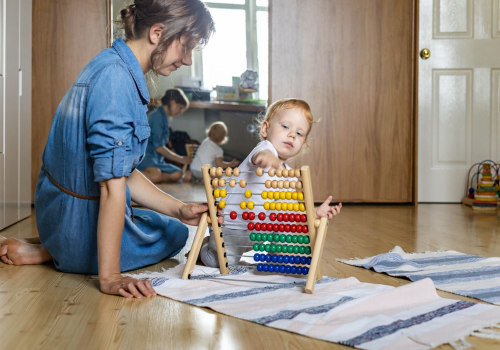The UK's Top TMUA Tutors in 2025 are a great resource for parents looking to help their children succeed in algebra, making them one of The Best Algebra Tutoring Websites. The concept of distributive property, one of the fundamental principles in algebra, is often covered in these online maths tutorials. This powerful tool allows us to simplify complex expressions and equations, making them easier to solve and understand. Therefore, understanding the distributive property is crucial for parents who want to support their children's learning. In this article, we will provide a comprehensive overview of the distributive property, breaking it down step by step and providing real-life examples. By the end of this article, you will have a clear understanding of the distributive property and how to apply it to various algebraic expressions. So let's dive into the world of algebra and discover the wonders of The Best Algebra Tutoring Websites and the distributive property. The distributive property is a fundamental concept in algebra that helps students simplify expressions. It states that multiplying a number by a group of numbers added together is the same as doing each multiplication separately.
This may seem simple, but many students struggle with applying this concept in more complex problems. To help your child understand the distributive property, it's important to provide them with practice exercises and worksheets that focus specifically on this concept. These exercises should start with basic problems, such as 3 * (2 + 5) and (3 * 2) + (3 * 5), to help them grasp the concept. As they become more comfortable with the idea, you can gradually introduce more challenging problems. You can also use real-life examples to make the distributive property more relatable for your child. For instance, if you have three apples and you want to share them equally with two friends, you can use the distributive property to determine how many apples each person will get.
This hands-on approach can help your child see the practical applications of the distributive property. In addition to practice problems and real-life examples, it's important to explain the reasoning behind the distributive property to your child. Let them know that it follows the same logic as distributing items among a group of people. Just as you would divide a group of apples among multiple people by giving each person an equal number of apples, the distributive property divides a number among multiple terms by multiplying each term by that number. As a parent, it's important to be patient and understanding when helping your child understand the distributive property. Some children may need more time to grasp the concept, so it's important to provide them with a supportive learning environment and encourage them to keep practicing. In conclusion, the distributive property is an essential concept in algebra that can help simplify complex expressions.
By providing your child with practice problems, real-life examples, and an understanding of the reasoning behind the property, you can effectively teach them this important concept and help them improve their algebra skills.
Practice Exercises and Worksheets
Provide your child with plenty of practice exercises and worksheets that focus on the distributive property. This will help them become more comfortable with applying the concept in different problems.Visual Aids
Some students may find it easier to understand the distributive property through visual aids. You can use diagrams or drawings to help them visualize the concept.Online Resources
There are many online resources available that offer interactive activities and games to help students practice the distributive property. These can be a fun and engaging way for your child to learn and reinforce their understanding of the concept.Real-Life Examples
Use real-life examples to make the distributive property more relatable for your child.You can use objects or situations from their everyday life to demonstrate how the concept works. For example, you can show them how the distributive property is used when distributing snacks to a group of friends. If there are 4 friends and you have 2 bags of chips, you can distribute the chips equally by using the distributive property. This helps your child see how the concept applies to a real-life situation and makes it easier for them to understand.
Another example could be using the distributive property when calculating the cost of multiple items at a store. If there are 3 items priced at $10 each, instead of adding $10 + $10 + $10, you can use the distributive property to simplify it as 3 x $10. This not only saves time but also reinforces the concept in a practical way. By using real-life examples, you can show your child that the distributive property is not just a math concept, but a useful tool in their everyday life.
Tips for Teaching the Distributive Property
To effectively teach the distributive property, consider these tips: 1.Start with concrete examples: It can be difficult for students to understand abstract concepts in algebra. To help them grasp the distributive property, use real-life scenarios and objects to demonstrate how it works.For example, show them how distributing candy equally to two friends is similar to distributing numbers in an algebraic expression. 2.Use visuals: Visual aids can make a big difference in understanding the distributive property. Create diagrams or use manipulatives like algebra tiles to show how the property works. This will help students visualize and better comprehend the concept.
3.Practice, practice, practice: Like with any new concept, practice is key. Provide your child with plenty of opportunities to apply the distributive property through worksheets, quizzes, and other activities. This will help reinforce their understanding and improve their skills. 4.Relate it to other concepts: The distributive property is closely related to other algebraic concepts, such as factoring and combining like terms.
Make connections between these concepts to help your child see how they are all interconnected. 5.Encourage mistakes: Learning is a process and making mistakes is a natural part of that process. Encourage your child to try different approaches and make mistakes along the way. This will help them learn from their errors and deepen their understanding of the distributive property. The distributive property is a key concept in algebra that helps students simplify expressions.
As a parent, it's important to provide your child with the necessary resources and support to help them master this concept. With practice, patience, and creative teaching methods, your child can develop a strong understanding of the distributive property and excel in algebra.











